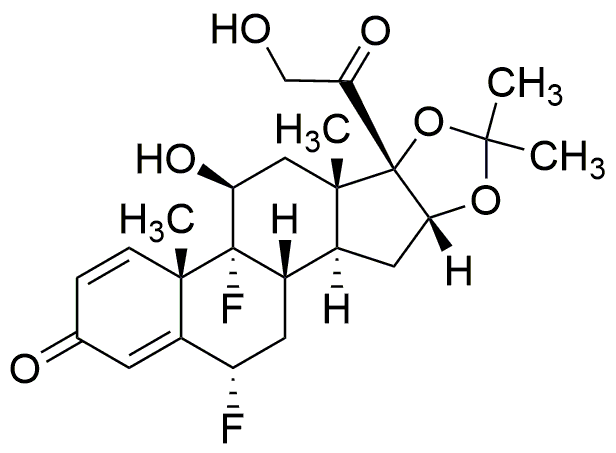Fluocinolone acetonide is widely utilized in research focused on:
- Dermatology Treatments: This compound is commonly used in topical formulations to treat various skin conditions such as eczema, psoriasis, and dermatitis, providing anti-inflammatory and antipruritic effects.
- Ophthalmology: It is effective in treating inflammatory conditions of the eye, such as uveitis, by reducing inflammation and preventing tissue damage.
- Veterinary Medicine: Fluocinolone acetonide is also applied in veterinary practices to manage skin disorders in animals, ensuring their comfort and health.
- Research Applications: In laboratory settings, it is used to study the mechanisms of inflammation and the effects of corticosteroids, aiding in the development of new therapeutic strategies.
- Cosmetic Formulations: The compound is incorporated into certain cosmetic products for its anti-inflammatory properties, helping to soothe irritated skin and improve overall skin health.
General Information
Properties
Safety and Regulations
Applications
Fluocinolone acetonide is widely utilized in research focused on:
- Dermatology Treatments: This compound is commonly used in topical formulations to treat various skin conditions such as eczema, psoriasis, and dermatitis, providing anti-inflammatory and antipruritic effects.
- Ophthalmology: It is effective in treating inflammatory conditions of the eye, such as uveitis, by reducing inflammation and preventing tissue damage.
- Veterinary Medicine: Fluocinolone acetonide is also applied in veterinary practices to manage skin disorders in animals, ensuring their comfort and health.
- Research Applications: In laboratory settings, it is used to study the mechanisms of inflammation and the effects of corticosteroids, aiding in the development of new therapeutic strategies.
- Cosmetic Formulations: The compound is incorporated into certain cosmetic products for its anti-inflammatory properties, helping to soothe irritated skin and improve overall skin health.
Documents
Safety Data Sheets (SDS)
The SDS provides comprehensive safety information on handling, storage, and disposal of the product.
Product Specification (PS)
The PS provides a comprehensive breakdown of the product’s properties, including chemical composition, physical state, purity, and storage requirements. It also details acceptable quality ranges and the product's intended applications.
Certificates of Analysis (COA)
Search for Certificates of Analysis (COA) by entering the products Lot Number. Lot and Batch Numbers can be found on a product’s label following the words ‘Lot’ or ‘Batch’.
*Catalog Number
*Lot Number
Certificates Of Origin (COO)
This COO confirms the country where the product was manufactured, and also details the materials and components used in it and whether it is derived from natural, synthetic, or other specific sources. This certificate may be required for customs, trade, and regulatory compliance.
*Catalog Number
*Lot Number
Safety Data Sheets (SDS)
The SDS provides comprehensive safety information on handling, storage, and disposal of the product.
DownloadProduct Specification (PS)
The PS provides a comprehensive breakdown of the product’s properties, including chemical composition, physical state, purity, and storage requirements. It also details acceptable quality ranges and the product's intended applications.
DownloadCertificates of Analysis (COA)
Search for Certificates of Analysis (COA) by entering the products Lot Number. Lot and Batch Numbers can be found on a product’s label following the words ‘Lot’ or ‘Batch’.
*Catalog Number
*Lot Number
Certificates Of Origin (COO)
This COO confirms the country where the product was manufactured, and also details the materials and components used in it and whether it is derived from natural, synthetic, or other specific sources. This certificate may be required for customs, trade, and regulatory compliance.


